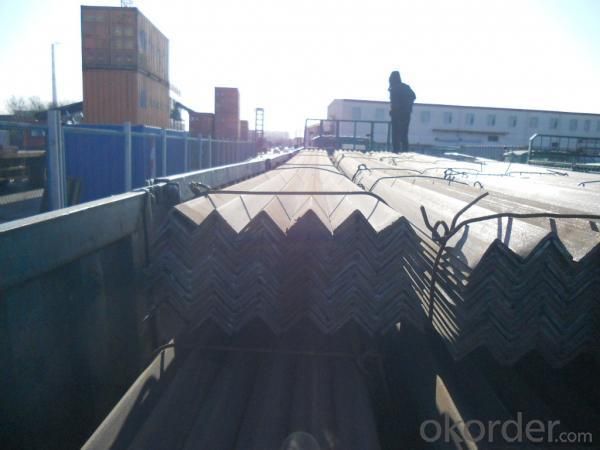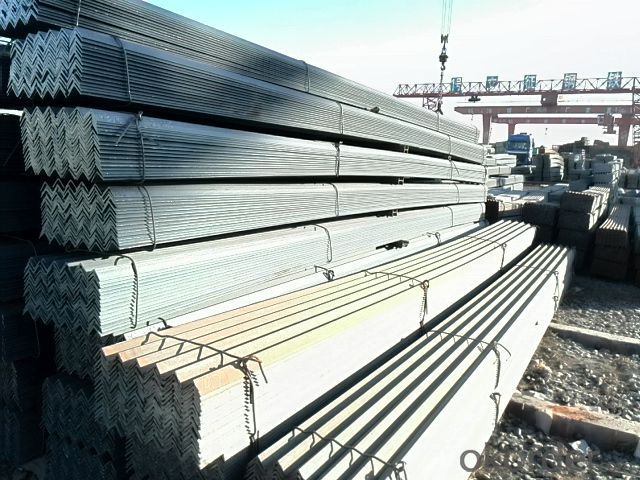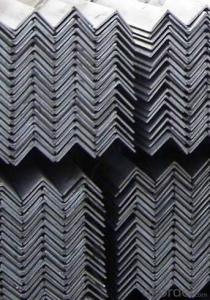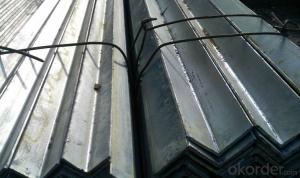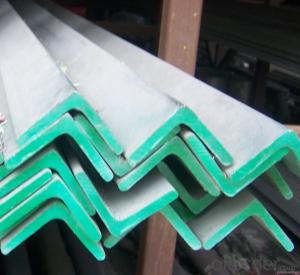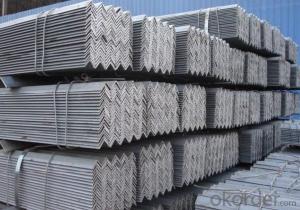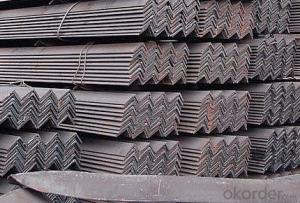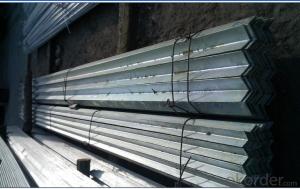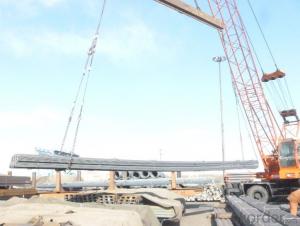Angle steel with high quality ; Steel angle
- Loading Port:
- Tianjin
- Payment Terms:
- TT OR LC
- Min Order Qty:
- 1000 m.t.
- Supply Capability:
- 30000 m.t./month
OKorder Service Pledge
OKorder Financial Service
You Might Also Like
Product Description:
Specifications of Angle Steel
1. Invoicing on theoretical weight or actual weight as customer request
2. Length: 6m, 9m, 12m as following table
3. Sizes
Sizes: 25mm-250mm | ||
a*t | ||
25*2.5-4.0 | 70*6.0-9.0 | 130*9.0-15 |
30*2.5-6.6 | 75*6.0-9.0 | 140*10-14 |
36*3.0-5.0 | 80*5.0-10 | 150*10-20 |
38*2.3-6.0 | 90*7.0-10 | 160*10-16 |
40*3.0-5.0 | 100*6.0-12 | 175*12-15 |
45*4.0-6.0 | 110*8.0-10 | 180*12-18 |
50*4.0-6.0 | 120*6.0-15 | 200*14-25 |
60*4.0-8.0 | 125*8.0-14 | 250*25 |
5. Payment terms:
1).100% irrevocable L/C at sight.
2).30% T/T prepaid and the balance against the copy of B/L.
3).30% T/T prepaid and the balance against L/C
6.Material details:
Alloy No | Grade | Element (%) | |||||
C | Mn | S | P | Si | |||
Q235 | B | 0.12—0.20 | 0.3—0.7 | ≤0.045 | ≤0.045 | ≤0.3 | |
Alloy No | Grade | Yielding strength point( Mpa) | |||||
Thickness (mm) | |||||||
≤16 | >16--40 | >40--60 | >60--100 | ||||
≥ | |||||||
Q235 | B | 235 | 225 | 215 | 205 | ||
Alloy No | Grade | Tensile strength (Mpa) | Elongation after fracture (%) | ||||
Thickness (mm) | |||||||
≤16 | >16--40 | >40--60 | >60--100 | ||||
≥ | |||||||
Q235 | B | 375--500 | 26 | 25 | 24 | 23 | |
Usage & Applications of Angle Steel
According to the needs of different structures, Angle can compose to different force support component, and also can be the connections between components. It is widely used in various building structures and engineering structures such as roof beams, bridges, transmission towers, hoisting machinery and transport machinery, ships, industrial furnaces, reaction tower, container frame and warehouse etc.
Packaging & Delivery of Angle Steel
1. Packing: it is nude packed in bundles by steel wire rod
2. Bundle weight: not more than 3.5MT for bulk vessel; less than 3 MT for container load
3. Marks:
Color marking: There will be color marking on both end of the bundle for the cargo delivered by bulk vessel. That makes it easily to distinguish at the destination port.
Tag mark: there will be tag mark tied up on the bundles. The information usually including supplier logo and name, product name, made in China, shipping marks and other information request by the customer.
If loading by container the marking is not needed, but we will prepare it as customer request.
- Q: What are the different types of steel angles used in engineering?
- In engineering, there are several different types of steel angles that are commonly used. These angles are typically made from hot-rolled steel and are available in various sizes and dimensions to suit different applications. Some of the different types of steel angles used in engineering include: 1. Equal angles: These angles have equal sides and are commonly used for structural purposes, such as supporting beams or columns. They provide stability and strength to the structure and are often used in construction projects. 2. Unequal angles: As the name suggests, unequal angles have different length sides. These angles are often used in applications where one side needs to be longer or shorter than the other, such as bracing or framing. 3. L-shaped angles: L-shaped angles have one side longer than the other, forming an L-shape. These angles are commonly used in construction to provide support and reinforcement, such as for corners, joints, or connections. 4. Structural angles: Structural angles are specifically designed to bear heavy loads and provide structural stability. They are commonly used in building frame structures, bridges, or other load-bearing applications. 5. Stainless steel angles: Stainless steel angles are made from stainless steel, which offers excellent corrosion resistance and durability. These angles are often used in environments where rust or corrosion may be a concern, such as marine applications or food processing facilities. 6. Galvanized steel angles: Galvanized steel angles are coated with a layer of zinc to provide corrosion resistance. These angles are commonly used in outdoor applications or environments where exposure to moisture or harsh conditions is expected. 7. Perforated steel angles: Perforated steel angles have holes or perforations along their length, allowing for improved ventilation or drainage. These angles are often used in applications where airflow or water drainage is required, such as in HVAC systems or outdoor structures. Overall, the choice of steel angle depends on the specific requirements of the engineering project. Factors such as load-bearing capacity, resistance to corrosion, and aesthetic considerations play a crucial role in selecting the appropriate type of steel angle for a particular application.
- Q: Can steel angles be used for supporting mechanical equipment?
- Yes, steel angles can be used for supporting mechanical equipment. Steel angles provide structural support, stability, and durability, making them suitable for supporting the weight and load of mechanical equipment. They are commonly used in various industries for this purpose due to their strength and versatility.
- Q: What are the environmental benefits of using steel angles?
- Using steel angles in construction and various industries offers numerous environmental advantages. Firstly, steel is a material that is highly recyclable. The production process of steel angles involves recycling scrap steel, which reduces the need for extracting and processing new raw materials. This recycling process helps conserve natural resources and reduces the energy and water consumption associated with mining and refining metals. Furthermore, steel is renowned for its durability and long lifespan. Steel angles have a long-lasting nature and require minimal maintenance, reducing the need for frequent replacements. This durability aids in minimizing waste and the environmental impact linked to manufacturing and disposing of new materials. Moreover, steel is a non-combustible material, making it a safer choice for construction. Unlike certain other materials, steel angles do not contribute to the spread of fires, reducing the risk of environmental damage and potential harm to human health. Additionally, steel is highly energy-efficient. Steel angles can be manufactured using processes that prioritize energy efficiency, and steel structures are known for their thermal efficiency. This means that steel buildings require less energy for heating and cooling, ultimately reducing overall energy consumption and greenhouse gas emissions. Lastly, the use of steel angles can contribute to sustainable building practices. Steel structures can be designed in a manner that maximizes natural light and ventilation, reducing the need for artificial lighting and air conditioning. Furthermore, steel can be easily repurposed or recycled at the end of its lifespan, further reducing waste and environmental impact. In conclusion, the utilization of steel angles yields environmental benefits such as recyclability, durability, non-combustibility, energy efficiency, and the promotion of sustainable building practices. By opting for steel angles in construction and industrial applications, we can effectively minimize resource consumption, waste generation, and greenhouse gas emissions, thereby fostering a more sustainable and environmentally-friendly future.
- Q: How do steel angles contribute to the overall sustainability of a building?
- Steel angles contribute to the overall sustainability of a building in several ways. Firstly, they are often made from recycled steel, reducing the demand for raw materials and the energy required for manufacturing. Additionally, steel angles are durable and long-lasting, reducing the need for frequent replacements and minimizing waste. Their strength and versatility also allow for efficient structural designs, optimizing the use of materials and reducing the overall weight of the building. Lastly, steel angles can be easily recycled at the end of their life cycle, further reducing the environmental impact of the building.
- Q: What is the purpose of using steel angles in construction?
- The purpose of using steel angles in construction is to provide structural support and stability. Steel angles are commonly used to reinforce corners, edges, and joints, ensuring the strength and rigidity of the overall structure. They help distribute the load evenly and resist torsional forces, making them essential for the construction of beams, frames, and various structural components.
- Q: Can steel angles be used for railings or barriers?
- Yes, steel angles can indeed be used for railings or barriers. Steel angles are commonly used in construction and are known for their strength and durability. They provide a sturdy and reliable structure for railings and barriers, ensuring the safety and security of the area. Steel angles can be easily welded or bolted together, allowing for easy installation and customization. Additionally, steel angles can be coated or painted to enhance their appearance and protect against rust and corrosion. Overall, steel angles are a popular choice for railings and barriers due to their strength, versatility, and longevity.
- Q: Do steel angles require any special maintenance?
- No special maintenance is needed for steel angles, but their lifespan can be prolonged with proper care and attention. It is recommended to regularly clean them to remove dirt, debris, and corrosive substances. Additionally, it is important to promptly address any signs of rust, cracks, or damage to prevent further deterioration. To prevent corrosion and extend the life of the steel angles, applying a protective coating or paint is advisable. In general, steel angles require minimal maintenance, but regular inspections and maintenance practices are crucial for optimal performance and longevity.
- Q: What is the maximum deflection allowed for steel angles?
- The maximum deflection allowed for steel angles depends on several factors such as the specific application, the load applied, and the design standards being followed. Generally, the maximum deflection for steel angles is determined by considering the acceptable level of aesthetic appearance and structural performance. Consulting the relevant design codes or consulting with a structural engineer would provide more specific information on the maximum allowable deflection for steel angles in a given situation.
- Q: What size does angle iron 125*10 mean?
- The width of the equal angles is 125mm and the thickness is 10mm
- Q: Can steel angles be used in construction?
- Yes, steel angles can be used in construction. Steel angles are commonly used as structural elements in construction projects due to their strength, durability, and versatility. They are commonly used to support and reinforce various structures such as buildings, bridges, and industrial frameworks. Steel angles provide stability and structural integrity, making them a suitable choice for construction purposes.
Send your message to us
Angle steel with high quality ; Steel angle
- Loading Port:
- Tianjin
- Payment Terms:
- TT OR LC
- Min Order Qty:
- 1000 m.t.
- Supply Capability:
- 30000 m.t./month
OKorder Service Pledge
OKorder Financial Service
Similar products
Hot products
Hot Searches
Related keywords



